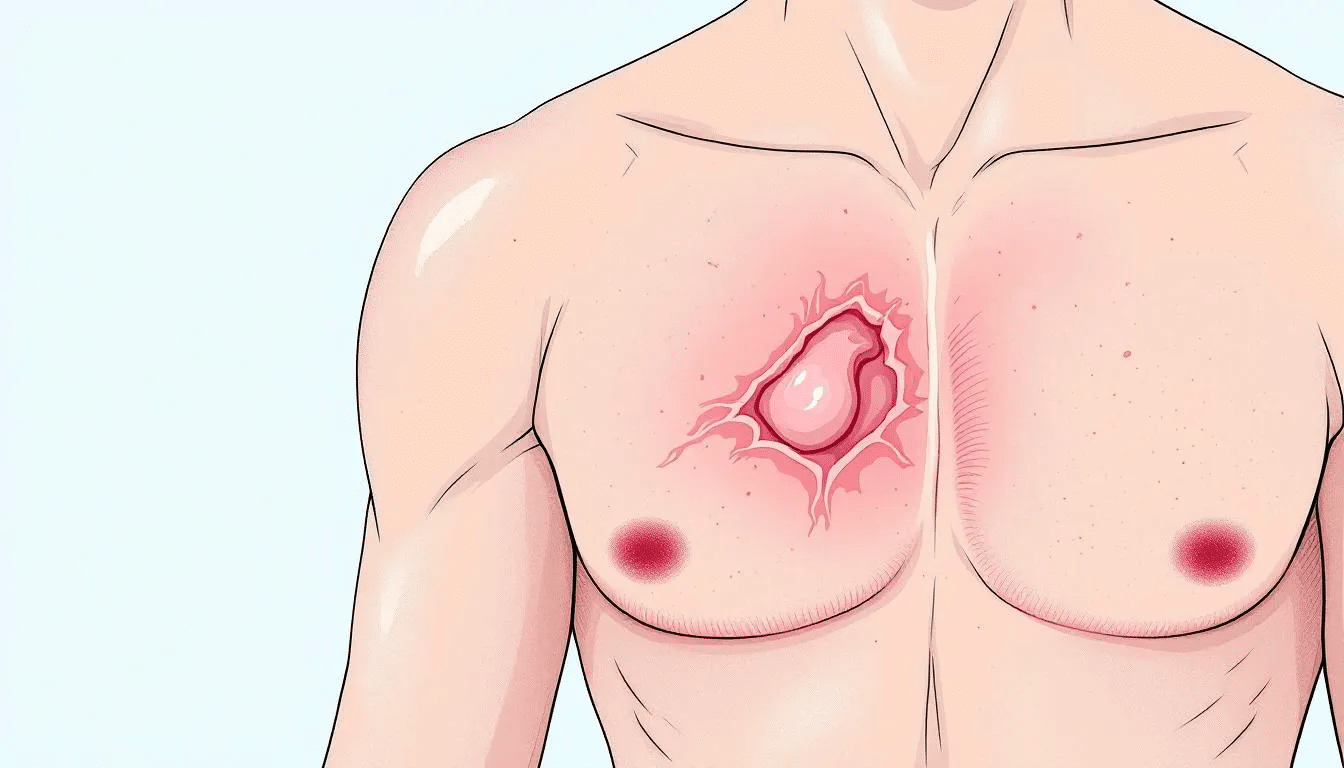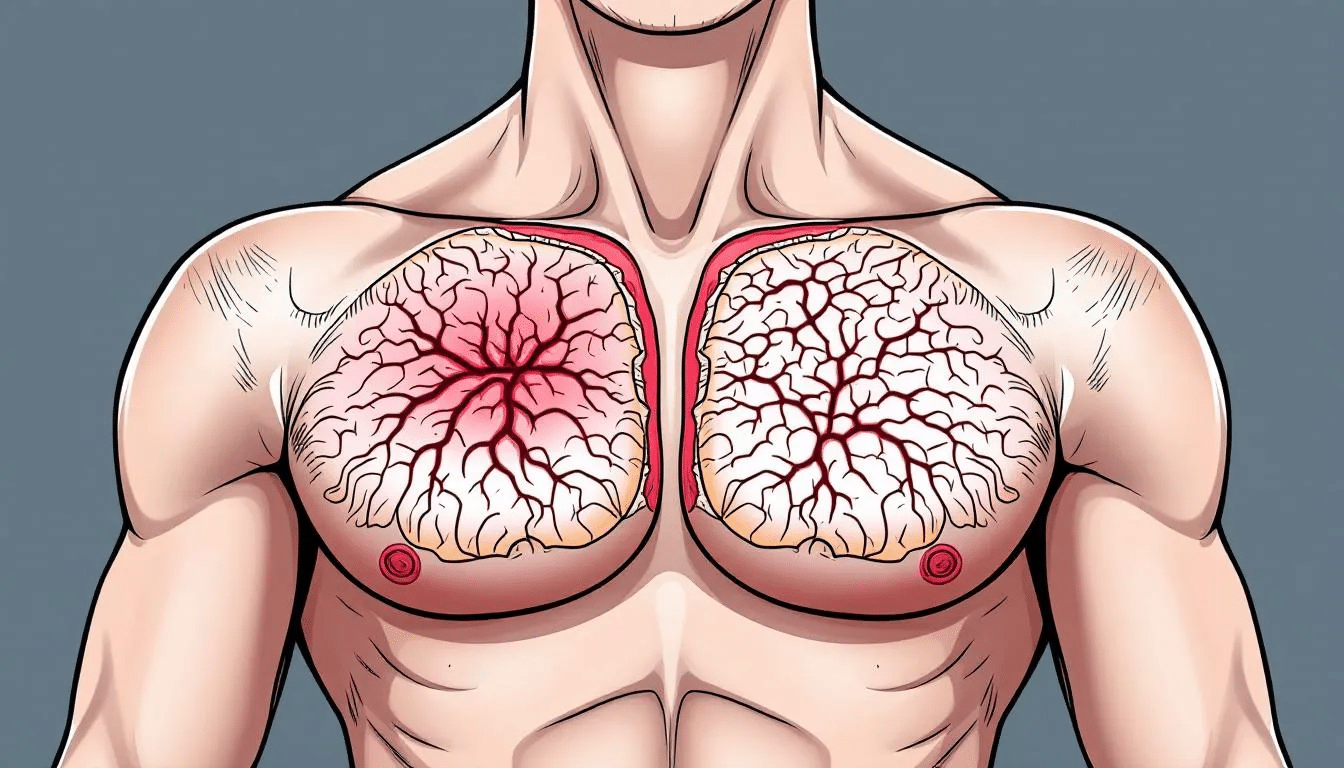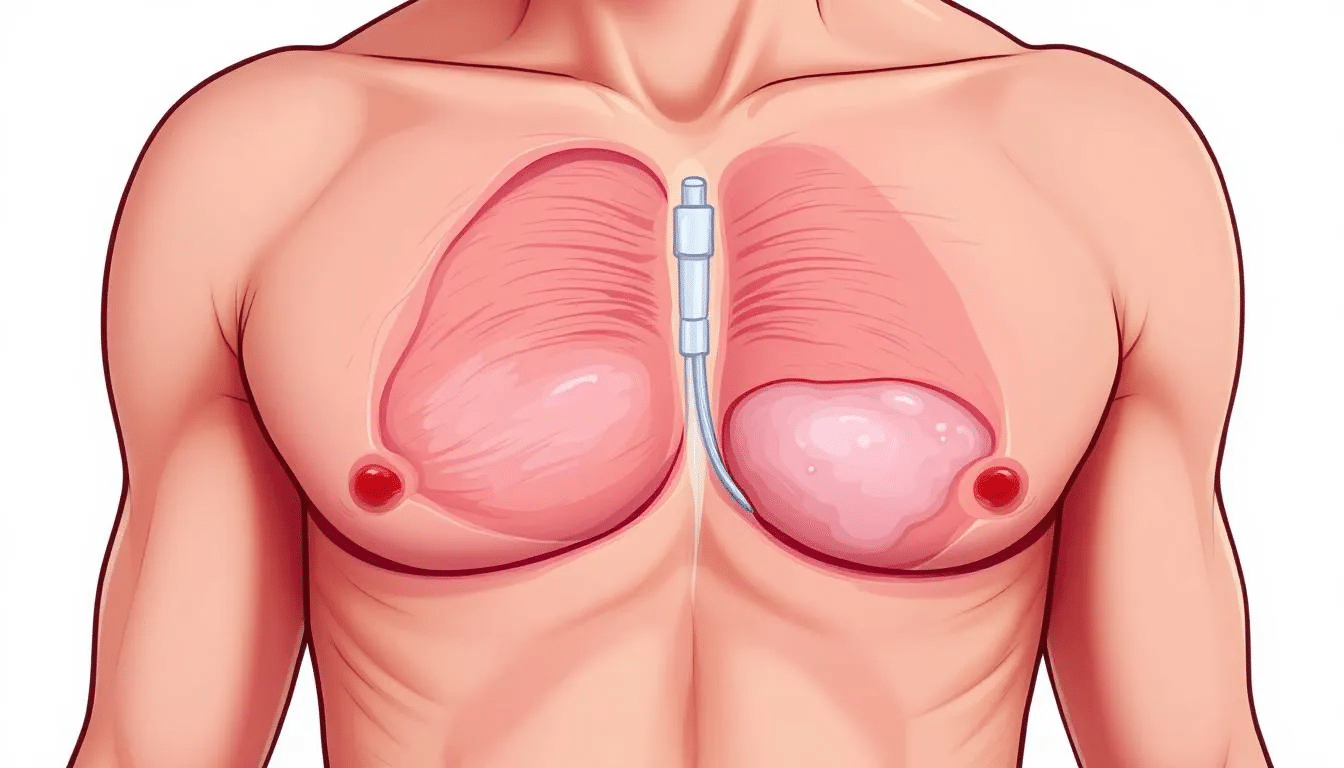Knowing how to spot early signs of surgical complications with gynecomastia surgery is essential. This guide will help you identify potential issues, such as infections or excessive bleeding, so that you can seek assistance promptly.

Key Takeaways
- Early signs of surgical complications after gynecomastia surgery include infection indicators like pus, fever, and elevated temperature, as well as monitoring for excessive bleeding and hematoma formation.
- Patients should be vigilant about the healing process, watching for abnormal scarring, nipple sensation changes, and persistent swelling or discoloration, which could indicate complications.
- Understanding complication rates for gynecomastia surgery helps patients make informed decisions and set realistic expectations about potential risks and outcomes.
- Consulting with a qualified expert, like Dr. Miguel Delgado, is crucial for addressing potential complications and ensuring a comprehensive approach to gynecomastia treatment.
- Overall complication rate for gynecomastia surgery is reported at 1.9%.
Introduction to Gynecomastia
Gynecomastia is a common condition in which males develop excess breast tissue, often leading to a softer or more prominent chest appearance. Gynecomastia can result from hormonal changes, particularly fluctuations in estrogen and testosterone. In gynecomastia, it is the glandular tissue—firm, fibrous breast tissue distinct from fatty tissue—that enlarges and causes the characteristic changes in the chest. Hormone imbalance is a common underlying cause of gynecomastia and may be related to medical conditions, medications, or lifestyle factors. This can cause significant emotional distress, impact self-esteem, and create discomfort in daily life. Gynecomastia surgery, also known as male breast reduction surgery, is a specialized surgical procedure designed to remove this excess breast tissue and restore a flatter, more masculine chest contour. The primary goal of male breast reduction is to improve the appearance of the chest, helping individuals regain confidence and enjoy a better quality of life. For many, this surgery is a life-changing step toward feeling comfortable in their skin.
Gynecomastia facts.
- Gynecomastia can affect approximately 50-65% of boys and men.
- Surgical intervention is often considered the most effective treatment option for gynecomastia.
- Gynecomastia is classified into four grades based on the severity of glandular tissue enlargement.
- Grade 1 gynecomastia is characterized by slight enlargement of breast tissue, noticeable only when not covered. Treatment for grade 1 gynecomastia typically includes gland excision and liposuction.
- Grade 2 gynecomastia presents mild to moderate breast enlargement that can often be concealed by clothing. Direct removal of the gland and liposuction is the standard treatment for grade 2 gynecomastia.
- Grade 3 gynecomastia is characterized by significant breast size increase, often referred to as ‘man boobs.’ Grade 3 treatment may require gland removal, liposuction, and possibly the elimination of excess skin.
- Grade 4 gynecomastia involves severe enlargement and excess skin that resembles drooping female breasts. The most effective treatment for grade 4 gynecomastia is a double incision mastectomy with a free-nipple graft.
- Gynecomastia surgery generally uses general anesthesia to ensure the patient is unconscious and pain-free during the procedure. In some cases, IV sedation or local anesthesia may be used.
Adolescent gynecomastia
Adolescent gynecomastia is a common condition during puberty, caused by changes in hormone levels—specifically, increased estrogen and decreased testosterone. This hormonal imbalance can lead to excess breast tissue growth in males as part of normal breast development, and it often resolves on its own within a few years.
Understanding Gynecomastia Surgery
Gynecomastia surgery (also referred to as gynaecomastia surgery in some regions) is a carefully planned surgical procedure that targets the removal of excess breast tissue, excess fatty tissue, and, when necessary, excess skin. The aim is to achieve a smooth, natural-looking chest that complements the patient’s body shape. Depending on the severity and type of gynecomastia, plastic surgeons may use different surgical options, such as liposuction to remove fatty tissue, direct excision to remove glandular breast tissue, or a combination of both techniques. Each approach is tailored to the individual’s needs, ensuring the best possible surgical outcomes and a chest contour that looks and feels natural.
Non-Surgical Alternatives
While male breast reduction surgery is often the most effective way to remove excess breast tissue and achieve a flatter chest, there are non-surgical alternatives that may help in some instances. Lifestyle modifications, such as adopting a healthy diet and engaging in regular exercise, can reduce excess fatty tissue and improve overall chest appearance, especially if gynecomastia is related to weight gain. In some instances, healthcare professionals may recommend certain medications or hormone therapies to address underlying hormonal imbalances that contribute to breast tissue growth. Additionally, non-surgical treatments like laser therapy, radiofrequency procedures, or minimally invasive liposuction techniques may be considered for mild cases or for those who are not candidates for surgery. However, these alternatives are generally less effective than reduction surgery for removing glandular breast tissue and may not fully resolve puffy nipples or achieve the desired chest contour. It’s essential to consult with a healthcare professional to determine the most appropriate treatment plan for your individual needs.
Cosmetic Surgery Considerations
Choosing cosmetic surgery for gynecomastia or puffy nipples is a significant decision that requires careful thought and expert guidance. Gynecomastia surgery is a specialized surgical procedure designed to remove excess breast tissue and fatty tissue, resulting in a more masculine chest appearance. While the benefits can be life-changing, it’s essential to understand that all surgical interventions carry potential complications, such as scarring, infection, and changes in nipple sensation. Consulting with a board-certified plastic surgeon is essential to discuss your goals, review your medical history, and learn about the healing process and expected recovery time. A qualified plastic surgeon will help you weigh the risks and benefits, set realistic expectations, and ensure you are fully informed before proceeding with cosmetic surgery. By taking the time to understand the procedure and potential outcomes, you can make a confident and informed decision about your care.
Preparing for Surgery
Proper preparation is key to achieving the best possible surgical outcomes and ensuring a smoother recovery process after gynecomastia surgery. Your plastic surgeon will provide a detailed pre-operative plan tailored to your needs. As part of this process, a preoperative assessment is conducted to evaluate your health and readiness for surgery. This often includes stopping certain medications, such as blood thinners and anti-inflammatory drugs, to minimize the risk of bleeding during the procedure. Maintaining a healthy lifestyle—eating a balanced diet, staying active, and avoiding smoking—can further support your body’s ability to heal. It’s also important to arrange for transportation to and from the surgical center and to have someone stay with you for at least the first night after surgery. By following your surgeon’s instructions and preparing in advance, you can help set the stage for a successful surgery and a comfortable recovery.
Tips for Preparing for Gynecomastia Surgery
To ensure a smooth recovery and minimize potential complications, it’s essential to be well-prepared for your gynecomastia surgery. Start by scheduling a consultation with a board-certified plastic surgeon to discuss the surgical procedure, your goals, and any concerns you may have. Obtaining medical clearance from your primary care provider may be required before surgery. Ensure you have realistic expectations about the results and understand the potential risks, including infection, scarring, and changes in nipple sensation. Prepare your home for your return by setting up a comfortable recovery area with loose-fitting clothing, extra pillows, and any prescribed medications. Carefully follow all pre- and post-operative instructions provided by your surgeon, including guidelines on wound care and activity restrictions. By taking these steps, you can help ensure a smooth recovery and achieve the best possible outcome from your surgery.
Minimizing Surgical Risks
Ensuring a smooth recovery and optimal surgical outcomes starts with minimizing surgical risks. Identifying and addressing individual risk factors, such as obesity or smoking, can help reduce the likelihood of complications. Patients can take proactive steps such as quitting smoking, avoiding certain medications that may increase bleeding risk, and maintaining a healthy weight before surgery. Selecting a board-certified plastic surgeon with extensive experience in gynecomastia surgeries is crucial for minimizing the risk of complications. Following all pre-operative instructions and attending scheduled post-operative appointments are key to a smooth recovery. By being diligent and informed, patients can help ensure their surgery is as safe and effective as possible.
Post-Operative Care for Gynecomastia Surgery
- Pain management is crucial in the first few days post-gynecomastia surgery.
- Patients will have a surgical drain to help fluid and blood drain from the area after surgery.
- Cold compresses can be beneficial for reducing pain and swelling after surgery, but should not be applied directly to the skin.
- It is advisable to sleep on your back and use pillows for support during the initial weeks of recovery following surgery.
- Monitoring during follow-up appointments is crucial to ensure no unusual swelling has developed post-surgery.
- Patients can typically return to light or sedentary work in about a week after gynaecomastia surgery.
- Exercise can typically resume in 4 to 6 weeks after gynaecomastia surgery.
Recognizing Early Signs of Infection
Infections are one of the most common complications following gynecomastia surgery and can significantly impact your recovery time. One of the first indicators of an infection is the presence of pus or unusual discharge from the incision site. The most common complication is superficial wound infections, occurring in approximately 1.3% of patients. This can often be accompanied by:
- severe pain
- swelling
- fever
- redness around the affected area.
Another critical sign to watch for is an elevated temperature. If you notice a spike in your body temperature post-surgery, it could be a warning sign of infection and warrants immediate attention. Maintaining clean and dry surgical dressings during recovery helps prevent infections. Proper wound care is essential for preventing infection and promoting healing.
Superficial wound infections are the most common complication and require prompt surgical intervention. Vigilance and proper hygiene can ensure a smoother recovery.
If an infection occurs post-surgery, it can often be treated with antibiotics.
Monitoring Healing Issues
The healing process after gynecomastia surgery can vary significantly from one patient to another. However, sure signs can indicate that the healing is not progressing as it should. Delayed wound healing can be a sign of underlying complications and should be monitored closely. Prolonged pain, persistent swelling, and an unusual firmness in the breast area are all red flags that need to be addressed.
It is important to note that certain medical conditions, such as diabetes or steroid use, can interfere with the healing process and increase the risk of complications.
If you experience excessive firmness in the breast area, it could be due to internal scarring in the breast tissue, which may require additional treatment. Regular follow-ups with your healthcare professional help keep your healing on track and address any unusual symptoms promptly.
Patients must wear a compression garment for 2 to 4 weeks following gynecomastia surgery to help minimize swelling and support the newly contoured chest.
Identifying Excessive Bleeding and Hematoma Formation
Excessive bleeding and hematoma formation are serious complications that can lead to prolonged recovery and require immediate medical attention. Signs of excessive bleeding include the incision opening, significant swelling, increased pain, and chest pain, which may indicate hematoma formation or a more serious cardiac or pulmonary complication. Injury to blood vessels during surgery can lead to hematoma formation, so careful surgical technique is essential to minimize this risk. Damage to deeper structures, such as muscles, can also contribute to complications and should be monitored for during recovery.
To minimize complications related to surgery:
- Avoid blood thinners before surgery to reduce the risk of excessive bleeding.
- Avoid anti-inflammatory medications before and after surgery to minimize bleeding risk.
- Be aware that bruising may be more visible depending on skin type.
- Apply cold compresses after the surgery to help reduce swelling and the likelihood of hematoma formation.
- Complications like bleeding or hematoma can require emergency treatment to drain accumulated blood or may necessitate a blood transfusion after surgery.
Immediate medical attention is necessary if there are signs of excessive bleeding, hematoma, or chest pain. Treatment may involve draining the accumulated blood.
Spotting Abnormal Scarring
Scarring is an inevitable part of any surgical procedure, including gynecomastia surgery. However, abnormal scarring can sometimes occur, which might affect the surgical outcomes. The two primary types of abnormal scars are hypertrophic scars and keloid scars.
Keloids are characterized by hard, raised scars that extend beyond the original wound margins, while hypertrophic scars are confined to the original incision area and may regress over time. Abnormal scarring might also involve tethering to underlying structures and abnormal pigmentation.
Monitoring for unusual scar tissue and considering treatments like topical silicone gel can improve scar texture, color, and height by enhancing skin hydration and regulating collagen production, leading to a smoother recovery process.
Detecting Nipple Sensation Changes
Changes in nipple sensation are common following gynecomastia surgery. Patients may experience heightened or diminished sensitivity in the nipple area. Temporary loss of nipple sensation is expected and can be a regular part of the recovery process.
While most changes in sensation are temporary, permanent loss of nipple sensation is rare but possible.
Complete restoration of normal sensation in the nipple may take several weeks to months after surgery. Please pay attention to any unusual or persistent sensations in the nipple area and discuss them with your surgeon.
Observing Skin Discoloration and Swelling
Bruising and swelling are typical occurrences after gynecomastia surgery. The skin surrounding the surgical area may show a color difference. It can appear either lighter or darker compared to the skin around it. Post-surgery, skin discoloration can manifest as bruising or changes in pigmentation.
While some swelling and discoloration are normal, they may persist for extended periods and can rarely be permanent. Monitoring for excessive swelling is essential, as it could indicate complications if it persists longer than expected.
Recognizing Signs of Seroma and Fluid Accumulation
A seroma is a fluid collection beneath the skin at the surgical site, often accompanied by swelling and discomfort. Seroma formation occurs in 2% to 5% of patients after gynecomastia surgery. This range highlights the potential for this complication following the procedure.
Minimizing the risk of seroma formation involves meticulous dissection, meticulous hemostasis, the use of drains, and the application of compression garments. If a seroma occurs, it may require drainage and should be thoroughly followed up by a healthcare professional.
Understanding Risks of Fat Necrosis
Fat necrosis is a potential complication of gynecomastia surgery. Symptoms include:
- Lumps beneath the skin
- Contour irregularities in the affected area
- Visible wrinkles
- Soft excess fatty tissue depressions
- Shape irregularities, such as wrinkling, dishing, or residual skin irregularities like ‘dog ears’
Larger areas affected by fat necrosis may require surgical removal to address lumps and contour issues. Complications from fat necrosis can also include infection, which may lead to the formation of an abscess requiring surgical drainage.
Watching for Allergic Reactions
Allergic reactions to certain medications and materials used during surgery can occur, though they are rare. Patients must disclose any known allergies to their surgeon to mitigate these risks. Discussing allergies before surgery prepares for potential complications and ensures a safer procedure.
Allergic reactions can occur due to materials such as:
- tape
- suture materials
- glues
- blood products
- topical preparations
- injected agents during the surgery
Local allergies to surgical materials, though rare, should be considered and addressed immediately.
Managing Blood Clots and Deep Vein Thrombosis
Blood clots and deep vein thrombosis are serious complications that can arise after gynecomastia surgery. These complications are considered serious. Symptoms of DVT can include swelling and pain in the leg, but some individuals may not exhibit any symptoms, referred to as silent DVT.
Regular movement, staying hydrated, and using compression stockings during long periods of immobility can help reduce the risk of deep vein thrombosis. Being aware of the dangers of blood clots after surgery is crucial for effective treatment and management.
Evaluating Nipple and Areola Changes
Changes in nipple and areola appearance are common after gynecomastia surgery. Nipple tethering occurs when scars attach the nipple to the chest wall, potentially impacting its appearance. Asymmetry in nipple and areola appearance can also arise from differences in pectoral muscle size or existing breast shape.
Most patients experience a gradual return of normal nipple sensation over several months after surgery.
Monitoring for unusual changes in nipple shape and areola appearance, including puffy areolas and puffy nipples, and consulting a plastic surgeon for plastic surgery corrective options if needed, is essential.
What to Expect After Surgery
After undergoing gynecomastia surgery, also known as male breast reduction surgery, it’s important to know what the recovery process will look like so you can prepare for a smooth healing journey. This surgical procedure is designed to remove excess breast tissue and excess fatty tissue, helping to create a flatter, more masculine chest contour. Immediately following the procedure, it’s common to experience some discomfort, swelling, and bruising in the breast area. These symptoms are a regular part of the body’s response to surgery and typically begin to subside within the first week.
During the initial days after reduction surgery, you may notice tightness or mild pain in the chest, especially when moving your arms or upper body. Your plastic surgeon will likely recommend wearing a compression garment to help reduce swelling, support the new chest shape, and promote optimal healing of the breast tissue and surrounding areas. It’s also normal to see some changes in skin color or mild numbness in the breast area as your body recovers.
Most patients can return to light activities or sedentary work within a week. Still, it’s important to avoid strenuous exercise or heavy lifting until your surgeon gives you the green light. Following all post-operative instructions, including caring for the surgical site and taking prescribed medications, will help minimize potential complications and support a smoother recovery process.
Remember, every patient’s healing timeline is unique; however, most individuals experience steady improvement in comfort and appearance over the first few weeks following surgery. If you have any concerns about your recovery or notice unusual symptoms, don’t hesitate to reach out to your healthcare provider for guidance. By understanding what to expect after gynecomastia surgery, you can approach your recovery with confidence and look forward to enjoying the results of your male breast reduction.
Long-Term Follow-Up and Monitoring
Long-term follow-up and monitoring are vital components of a successful healing process after gynecomastia surgery. Regular check-ins with your plastic surgeon allow for early detection of potential complications and ensure that your recovery is progressing as expected. Maintaining a healthy lifestyle, including a balanced diet and regular physical activity, supports ongoing healing and helps preserve the benefits of your surgical outcomes. By prioritizing long-term care and staying in close contact with your healthcare provider, you can enjoy a smoother recovery process and lasting results from your male breast reduction.
The outcome of gynecomastia surgery is usually long-lasting, with complete gland removal ensuring minimal recurrence.
Emotional and Psychological Impact
The emotional and psychological impact of gynecomastia can be profound, often affecting self-esteem and overall well-being. Post-surgical assessments reveal significant improvements in various psychological areas, including emotional well-being and social functioning.Undergoing gynecomastia surgery can be a transformative experience, helping to restore confidence and improve quality of life. However, it’s essential to recognize and address the emotional aspects of this journey. Seeking support from healthcare professionals, therapists, or support groups can be invaluable in coping with the psychological effects of gynecomastia and the recovery process. By acknowledging and addressing these feelings, individuals can achieve not only physical but also emotional healing, leading to a more positive and successful surgical experience. Many patients report feeling less isolated and embarrassed after undergoing surgery for gynaecomastia.
Young patients often experience a more pronounced boost in self-esteem following gynecomastia surgery compared to older individuals.
Travel and Accommodation
If you are traveling for gynecomastia surgery, thoughtful planning can make your experience more comfortable and stress-free. Choose accommodation close to your surgical center to make attending follow-up appointments easier and to reduce travel-related fatigue during your recovery. Many surgical centers can recommend local hotels or recovery facilities that cater to the needs of surgical patients. It’s also wise to bring a trusted friend or family member with you, especially for the first few days after surgery, to assist with daily tasks and provide emotional support. By organizing your travel and accommodation in advance, you can focus on your healing and enjoy peace of mind throughout your surgical journey.
Call Dr. Delgado for a free consultation.
Dr. Miguel Delgado is recognized as a leading expert in gynecomastia surgery, attracting patients from around the world for his specialized treatment. During consultations, Dr. Delgado ensures that patients receive comprehensive information and answers to their questions regarding gynecomastia treatment options.
Patients can book a complimentary consultation with Dr. Delgado online or by phone to discuss their concerns about gynecomastia and explore personalized treatment options.
Travel Patients: Places of interest in San Francisco, California
San Francisco is not only renowned for its world-class medical facilities and expert plastic surgeons, such as Dr. Miguel Delgado, but also offers a vibrant cultural and recreational environment for patients traveling for gynecomastia surgery. The city boasts iconic landmarks such as the Golden Gate Bridge, Alcatraz Island, and the bustling Fisherman’s Wharf, providing ample opportunities for sightseeing and relaxation during your recovery period.
Visitors can enjoy the serene beauty of Golden Gate Park, explore the eclectic neighborhoods like Chinatown and the Mission District, or indulge in the culinary delights available throughout the city. For those interested in arts and science, the Exploratorium offers interactive exhibits, while the San Francisco Museum of Modern Art showcases contemporary artworks.
Choosing San Francisco as your surgical destination allows you to combine your medical journey with a memorable experience in a city celebrated for its diversity, innovation, and scenic charm. Many patients find that a comfortable and engaging environment has a positive impact on their overall healing process and emotional well-being.
When planning your stay, consider accommodations near the surgical center to facilitate easy access to follow-up appointments and minimize travel stress. Whether you prefer a quiet retreat or a lively urban setting, San Francisco offers a variety of lodging options to suit your needs.
Overall, San Francisco provides an excellent backdrop for your gynecomastia surgery experience, blending top-tier medical care with enriching cultural and leisure activities to support a smooth and enjoyable recovery.
Summary
Recognizing the early signs of surgical complications is paramount to ensure a successful recovery after gynecomastia surgery. Early detection of these complications can significantly improve recovery and overall outcomes. From infections to fat necrosis, understanding these signs can help you take proactive measures for a smoother recovery process.
Being vigilant about your post-operative care and consulting with a trusted healthcare professional like Dr. Miguel Delgado can make all the difference. Stay informed, monitor your symptoms, and don’t hesitate to seek medical advice when needed.
While gynecomastia is a benign condition, it is essential to distinguish it from breast cancer. If you notice unusual lumps or changes in the breast area, consult your healthcare provider to rule out breast cancer and address any concerns.
FAQ’sFrequently Asked Questions
Is gynecomastia surgery an outpatient procedure?
Yes, gynecomastia surgery is typically performed as an outpatient procedure, allowing patients to return home the same day.
What type of anesthesia is used for gynecomastia surgery?
General anesthesia is commonly used for gynecomastia surgery. While generally safe, it carries risks such as cardiac issues and pulmonary complications.
What are the inherent risks of gynecomastia surgery?
Potential complications include infection, scarring, anesthesia risks, hematoma, and changes in nipple sensation.
What is the surgical treatment for gynecomastia?
Surgical treatment involves the removal of excess tissue, often through direct removal of the gland and/or liposuction.
What is direct removal in gynecomastia surgery?
Direct removal refers to the excision of glandular tissue, often combined with liposuction for optimal results.
When is revision surgery needed after gynecomastia surgery?
Revision surgery may be required in cases of complications such as nipple necrosis, unsatisfactory results, or to correct issues with nipple healing.
What are the severe complications of gynecomastia?
Severe cases may involve infections requiring hospitalization, significant nipple or skin issues, or nipple retraction.
What is the excess tissue in gynecomastia?
Excess tissue refers to the glandular or fatty tissue beneath the nipple that causes breast enlargement and puffy nipples.
Can loose-fitting clothing help with gynecomastia?
Loose-fitting clothing can help conceal mild to moderate gynecomastia by hiding the appearance of enlarged male breasts.
What is breast augmentation, and is it related to gynecomastia surgery?
Breast augmentation is a procedure to enhance breast size, typically performed for women. It may be discussed in the context of correcting chest shape or symmetry, but it is different from gynecomastia surgery.
Does Dr. Delgado offer a free consultation for gynecomastia surgery?
Yes, Dr. Delgado provides a free consultation for gynecomastia surgery.
How long does it typically take for bruising to subside after gynecomastia surgery?
Bruising typically subsides within one to two weeks after gynecomastia surgery. This timeframe allows for the natural healing process to occur effectively.
What product did Dr. Delgado recommend for his patients?
Dr. Delgado recommends VitaMedica for his patients, as it meets and exceeds his requirements for surgery recovery.
How soon can a patient start exercising after gynecomastia surgery?
A patient can typically start light exercise within a few weeks post-surgery, but should avoid strenuous activities for 4-6 weeks to ensure proper healing. Always consult your surgeon for personalized advice.









